Hawaii’s airlines have played a vital role in connecting the islands and supporting tourism for a century. There is a rich evolution and history of these airlines with fascinating milestones and personal anecdotes. And yet, these airlines, far from the mainstream and mainland, have not always been successful. That remains true to this day.
From the pioneering days of Aloha Airlines to modern advancements like the Hawaiian Airlines’ Dreamliner and the many smaller airlines that have come and gone in Hawaii, our air travel history is rich and still evolving. But these airlines continue to fundamentally connect the islands as well as support Hawaii tourism.
This comes as Hawaii air travel sits at the precipice of perhaps its biggest change in the past 100 years. Hawaiian Airlines is facing unprecedented challenges that will lead to a major transformation that will inevitably start within weeks. With financial difficulties exacerbated by recent events, the airline is either on the brink of bankruptcy or its acquisition by Alaska Airlines.
That situation marks a critical juncture for Hawaii’s largest carrier, affecting both the local economy, Hawaii travel overall, and vital interisland connectivity. See: DOJ “Unlikely to Approve” Hawaiian/Alaska Deal + Southwest’s Tailspin Risks Hawaii Travel.
Legacy of rapid-paced, Hawaii-based airlines.
Hawaii has been home to an amazing litany of airline comings and goings over the years, including Aloha Airlines, Hawaiian Airlines, Mokulele Airlines, Island Air, Pacific Wings, Go! Airlines, Mid Pacific Air, Royal Hawaiian Air Service, Mahalo Air, Discovery Airways, Princeville Airways, and Interisland Airways. We’ve probably missed a few in there too.
The early days of Hawaii’s airline history.
Aloha Airlines: A legacy of island skies is unending.
Founded in 1946 as Trans-Pacific Airlines, Aloha Airlines had a rich history, and served Hawaii until its bankruptcy and closure in 2008. Fabled, and perhaps best remembered for its coupon books and minimal check-in times, Aloha Airlines left a lasting positive impression that still endures years after its demise.
In terms of key events in its history, the 1988 incident of flight 243 is one that lives on in the annals aviation safety. That incident was a significant event in aviation history overall, underscoring the importance of safety. On April 28, 1988, the aircraft suffered explosive decompression when a section of the fuselage roof ruptured, leading to a catastrophic failure. Despite the severity of the situation, the crew managed to land the plane safely on Maui, although there was one fatality and several injuries. This incident led to major changes in airline maintenance protocols industry-wide, and highlighted the resilience and professionalism of the Aloha crew. For a detailed account, see Remembering Aloha Flight 243.
The lead photo is that of an Aloha Airlines DC-10. Starting in 1984, the company flew the plane, under the brand name Aloha Pacific, between Honolulu, Guam, and Taipei. The service only lasted one year due to fierce competition from Continental (now United) and difficulty it had obtaining authorization for further international flights.
Hawaiian Airlines: The lumbering giant.
Established in 1929, Hawaiian Airlines is the largest airline ever in Hawaii, known for its extensive interisland, mainland and international routes. They operate in total more than 60 aircraft. The airline Introduced jet services to Hawaii in the 1960’s and expanded routes across the Pacific. It remains one of the leaders in Hawaii passenger service with a partially modernized fleet that includes decade-old Airbus A330’s, two new Boeing 787 Dreamliners, and an aging twenty-five year old interisland fleet of Boeing 717 planes.
Hawaiian serves dozens of destinations across the Pacific and North America. Employing more than 7,000 people, Hawaiian Airlines is Hawaii’s largest private employer, playing a critical role in both the state’s economy and passenger connectivity. The airline has had an outstanding reputation related to safety, and service, maintaining a significant presence in the U.S. aviation industry. Its long-standing esteem for punctuality has been somewhat tarnished.
Mokulele Airlines: Connecting Communities but troubled.
Launched in 1994, Mokulele Airlines focused on commuter services within Hawaii. Do you remember that one point, Mokulele Airlines had ambitious plans to acquire wide-body Boeing 767 planes and start services between Hawaii, Illinois, and London? These plans never quite materialized. The airline has since refocused on enhancing interisland services and improving operational efficiency. Known for its scenic low-flying flights and personalized service, Mokulele remains a vital part of Hawaii’s air travel network.
Mokulele Airlines has faced significant criticism and challenges, particularly regarding its reliability and service quality. Residents have expressed concerns over frequent flight cancellations and delays and some have reported being stranded due to weather and mechanical issues, made worse by the airline’s limited fleet and operational inefficiencies.
Island Air: A brief but impactful presence.
The company was founded in 1980 as Princeville Airways, then rebranded to Island Air in 1992. It provided vital interisland services until ceasing operations in 2017. It is largely remembered for its role in connecting smaller Hawaiian communities.
The airline went through several ownership changes, including its notable acquisition by billionaire Larry Ellison in 2013. Ellison, who to this day also owns most of the island of Lanai, aimed to expand Island Air’s services, especially to his island. Despite efforts to rejuvenate the airline with a new fleet of Q400 aircraft and rebranding initiatives, Island Air struggled with competition, financial losses, and operational challenges. These included reliability issues with its aging fleet and increased competition from also now defunct Ohana by Hawaiian Airlines‘ service. Ultimately, Island Air airline was sold again in 2016, with the new owners were unable to turn it around, leading to its ultimate demise.
Pacific Wings: Another small Hawaii airline player.
Pacific Wings began operations in 1974 as charter operator Air Nevada, then later rebranded to Pacific Wings. In 2007, they started flights between Oahu, Molokai, Lanai and Maui, with $49 fares on all seats on all flights. That only lasted two years, however. The airline terminated all Hawaii flights and closed down in 2014.
Go! Airlines: A Short-Lived and controversial Hawaii airline endeavor.
Go! Airlines, operated by Mesa Airlines, started interisland Hawaii flights in 2006, but quickly becoming embroiled in controversy. The airline was widely criticized for both its impact on the local aviation market and its operational issues.
One of the most contentious parts of Go!’s history was its aggressive pricing strategy, which many believe contributed to the 2008 Aloha Airlines bankruptcy. Go! was accused of predatory pricing, offering fares as low as $1, forcing competitors to lower their prices unsustainably.
Go! Airlines also faced numerous operational issues including the infamous 2007 incident, when two Go! pilots fell asleep during a flight from Honolulu to Hilo. The plane overshot its destination by 25 miles before air traffic controllers could finally wake the pilots. This incident highlighted serious concerns about crew fatigue and safety practices within the airline and industry-wide.
The airline never gained significant popularity among residents and relied heavily on tourist traffic booked through OTA’s. Frequent delays, a small and uncomfortable jet fleet, and poor customer reviews further tarnished Go!’s reputation. By 2014, faced with financial losses and unable to compete effectively, Go! Airlines ceased operations, marking the end of its largely unpleasant tenure in Hawaii
Mid Pacific Air: A Budget-Friendly Option.
Mid Pacific operated from 1981 to 1988, and was known for affordable interisland flights. In terms of its legacy, many residents fondly recall the airline’s budget-friendly services. Mid Pacific began operations here in 1981, connecting Kauai, Oahu, Maui, and the Big Island, competing with Hawaiian and Aloha Airlines. Despite low fares, it struggled to compete successfully and ceased passenger flights in January 1988.
Royal Hawaiian Air Service: known for unforgettable scenic routes.
Royal Hawaiian began in 1963 as Hawaii Wings, an air tour operator. It was how BOH editor Jeff arrived on Kauai in 1970. It was known for its scenic low-altitude flights using Cessna 402 aircraft, offering unparalleled views of the islands, they also connected smaller Hawaii airports including Hawaii’s Princeville, which many passengers still fondly remember.
Beat of Hawaii community stories in comments.
We’ve had hundreds of reader comments about the history of Hawaii airlines since we began publishing now approaching two decades ago.
Rob: “Flying Royal Hawaiian Air Service in 1980 was incredible because of how low they flew. I recall flying at altitudes of less than 1,000 feet.”
Diana V: “We used to fly Mid Pacific Air in the early 80s. It was affordable and reliable, perfect for weekend getaways.”
Lisa K: “I remember the fun of using Aloha Airlines’ coupon books in the 90s. It made interisland travel so easy and affordable.”
Michael H: “Hawaiian Airlines has always been my go-to for reliability. Their service over the years has only gotten better.”
Gerald R: “My wife and I flew from Hawaii to American Samoa with a short stop on Johnston Island in 1972. Do not remember what airways it was we flew on.
Can we please add your comments to these about airlines of Hawaii?
Get Breaking Hawaii Travel News

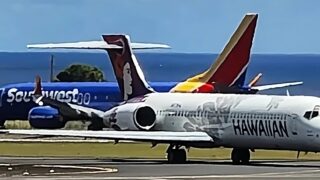
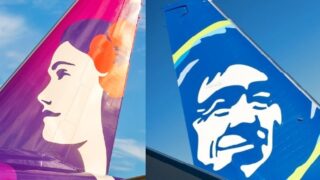
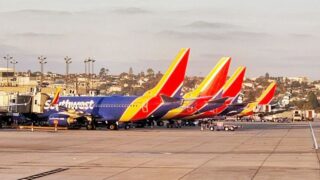

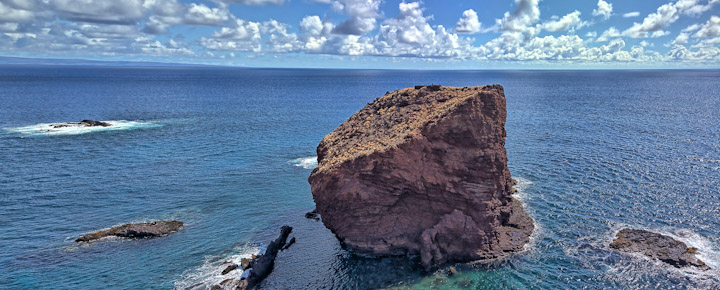
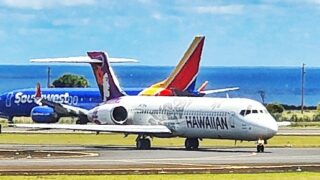
Just “One Step”??? Being awfully kind there aren’t ya guys???
Best Regards!
Our first vacation to Hawaii was to happen during Spring Break 1984. Our family of three was on a tight budget but we found an airline that had inexpensive tickets. Hawaii Express had one 747-100 that flew to HNL from LAX. After purchasing the tickets this airline went out of business before our trip. We were so disappointed plus they only reimbursed us $75. It took another year before we finally had our Hawaiian vacation.
The single biggest challenge for any Hawaii-based airline is the profitability of inter-island flights. The fixed costs of aircraft, fuel, labor, and airport facilities mean that unless heavily subsidized, service cannot be delivered at an affordable cost. Heavy competition from mainland carriers deprives Hawaii-based airlines from earning the revenue needed to subsidize inter-island service, compounded by the fact that as a primarily leisure destination, there isn’t sufficient business demand for higher-yielding fares.
Unless the federal government is prepared to put all inter-island flights under the EAS (essential air services) umbrella, something not likely to happen under Any administration, not much is going to change anytime soon.
Just when I was wondering “where’s the answer to the headline question?” here it is, in the *comments*. Thanks, Drew808!
Regarding Royal Hawaiian Air, do Rob and Jeff remember the Windsock Bar located in the small A-frame terminal at the old Kaanapali Airport? (Airport closed in 1986 for hotel/condo development) I remember it well from flights to Kalaupapa in 1978 and 1979. Great memories of taking church youth groups to paint the parish hall at Kana’ana Hou Congregational Church, and help with clean up at the Siloana Congregational Church on the other side of the peninsula.
All pretty much closed up today.
Spectacular Molokai setting!
Aloha to all.
Hi Daryl.
Hi Daryl.
Thanks. No somehow both of us miss seeing that.
Aloha.
If only there was an airline that provided quality service at a reasonable price. Wishful thinking 🙁
Rooting for the seaglider by Regent for interisland travel ….